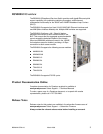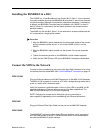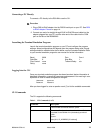
10 March 2005 BSX8-A2-GZ40-10
3. Click on Submit.
Command Line Interface (CLI)
CLI System Requirements
Straight-Through RJ45 to RJ45 Ethernet Cable – Required for establishing
a direct connection from the COM port to a DB9 adapter.
DB9 Female to RJ45 Male Adapter – Required for conversion of your PC's
RS232 serial port for use with the RJ45 to RJ45 Ethernet cable.
Terminal Emulation Program – Required for running the CLI over a direct
connection. The program must emulate a VT100 terminal.
Telnet Client – Required for remote management with the CLI. Microsoft
Windows Operating Systems (98, 2000, NT, and XP) include a Telnet client
which is executed using the Windows command prompt (cmd.exe). If you are
using an operating system other than Windows, you may need to install a
Telnet client.
Flood Configuration Flood refers to the method in which interface modules
handle unknown unicasts, unknown broadcasts, and
unknown multicasts for each port.
Uplink – Any traffic with VLAN IDs that match a
VLAN ID that has been configured to Uplink flood
(default) will be allowed to flow from DSL ports to
uplinks only (not DSL port to DSL port).
VLAN – Any traffic with VLAN IDs that match a
VLAN ID that has been configured to VLAN flood
will be allowed to flow from DSL port to uplinks and
DSL port to DSL port.
Flood Membership
Configuration
Specify the VLAN membership of the uplink ports
(four fixed ports and any MIM ports).
By default all uplinks are members of all VLANs.
However you can change it such that an uplink port is
a member of only a certain set of VLAN IDs. In this
case any ingress or egress traffic on an uplink port
with a VLAN ID that the uplink port is not a member of,
will be dropped.
Parameter Description


















